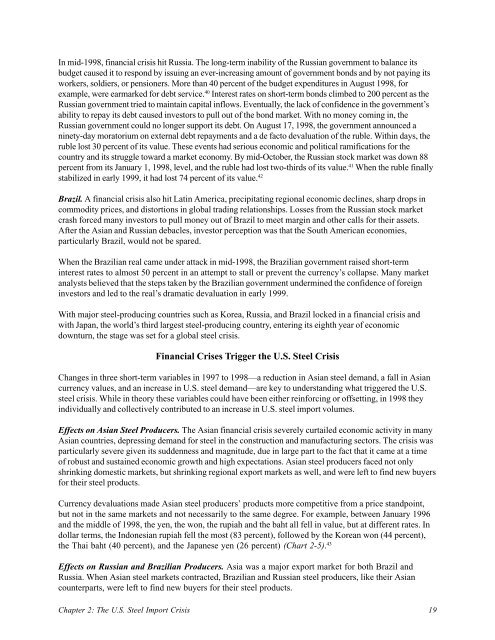Global Steel Trade; Structural Problems and Future Solutions
Global Steel Trade; Structural Problems and Future Solutions
Global Steel Trade; Structural Problems and Future Solutions
You also want an ePaper? Increase the reach of your titles
YUMPU automatically turns print PDFs into web optimized ePapers that Google loves.
In mid-1998, financial crisis hit Russia. The long-term inability of the Russian government to balance its<br />
budget caused it to respond by issuing an ever-increasing amount of government bonds <strong>and</strong> by not paying its<br />
workers, soldiers, or pensioners. More than 40 percent of the budget expenditures in August 1998, for<br />
example, were earmarked for debt service. 40 Interest rates on short-term bonds climbed to 200 percent as the<br />
Russian government tried to maintain capital inflows. Eventually, the lack of confidence in the government’s<br />
ability to repay its debt caused investors to pull out of the bond market. With no money coming in, the<br />
Russian government could no longer support its debt. On August 17, 1998, the government announced a<br />
ninety-day moratorium on external debt repayments <strong>and</strong> a de facto devaluation of the ruble. Within days, the<br />
ruble lost 30 percent of its value. These events had serious economic <strong>and</strong> political ramifications for the<br />
country <strong>and</strong> its struggle toward a market economy. By mid-October, the Russian stock market was down 88<br />
percent from its January 1, 1998, level, <strong>and</strong> the ruble had lost two-thirds of its value. 41 When the ruble finally<br />
stabilized in early 1999, it had lost 74 percent of its value. 42<br />
Brazil. A financial crisis also hit Latin America, precipitating regional economic declines, sharp drops in<br />
commodity prices, <strong>and</strong> distortions in global trading relationships. Losses from the Russian stock market<br />
crash forced many investors to pull money out of Brazil to meet margin <strong>and</strong> other calls for their assets.<br />
After the Asian <strong>and</strong> Russian debacles, investor perception was that the South American economies,<br />
particularly Brazil, would not be spared.<br />
When the Brazilian real came under attack in mid-1998, the Brazilian government raised short-term<br />
interest rates to almost 50 percent in an attempt to stall or prevent the currency’s collapse. Many market<br />
analysts believed that the steps taken by the Brazilian government undermined the confidence of foreign<br />
investors <strong>and</strong> led to the real’s dramatic devaluation in early 1999.<br />
With major steel-producing countries such as Korea, Russia, <strong>and</strong> Brazil locked in a financial crisis <strong>and</strong><br />
with Japan, the world’s third largest steel-producing country, entering its eighth year of economic<br />
downturn, the stage was set for a global steel crisis.<br />
Financial Crises Trigger the U.S. <strong>Steel</strong> Crisis<br />
Changes in three short-term variables in 1997 to 1998—a reduction in Asian steel dem<strong>and</strong>, a fall in Asian<br />
currency values, <strong>and</strong> an increase in U.S. steel dem<strong>and</strong>—are key to underst<strong>and</strong>ing what triggered the U.S.<br />
steel crisis. While in theory these variables could have been either reinforcing or offsetting, in 1998 they<br />
individually <strong>and</strong> collectively contributed to an increase in U.S. steel import volumes.<br />
Effects on Asian <strong>Steel</strong> Producers. The Asian financial crisis severely curtailed economic activity in many<br />
Asian countries, depressing dem<strong>and</strong> for steel in the construction <strong>and</strong> manufacturing sectors. The crisis was<br />
particularly severe given its suddenness <strong>and</strong> magnitude, due in large part to the fact that it came at a time<br />
of robust <strong>and</strong> sustained economic growth <strong>and</strong> high expectations. Asian steel producers faced not only<br />
shrinking domestic markets, but shrinking regional export markets as well, <strong>and</strong> were left to find new buyers<br />
for their steel products.<br />
Currency devaluations made Asian steel producers’ products more competitive from a price st<strong>and</strong>point,<br />
but not in the same markets <strong>and</strong> not necessarily to the same degree. For example, between January 1996<br />
<strong>and</strong> the middle of 1998, the yen, the won, the rupiah <strong>and</strong> the baht all fell in value, but at different rates. In<br />
dollar terms, the Indonesian rupiah fell the most (83 percent), followed by the Korean won (44 percent),<br />
the Thai baht (40 percent), <strong>and</strong> the Japanese yen (26 percent) (Chart 2-5). 43<br />
Effects on Russian <strong>and</strong> Brazilian Producers. Asia was a major export market for both Brazil <strong>and</strong><br />
Russia. When Asian steel markets contracted, Brazilian <strong>and</strong> Russian steel producers, like their Asian<br />
counterparts, were left to find new buyers for their steel products.<br />
Chapter 2: The U.S. <strong>Steel</strong> Import Crisis 19
















